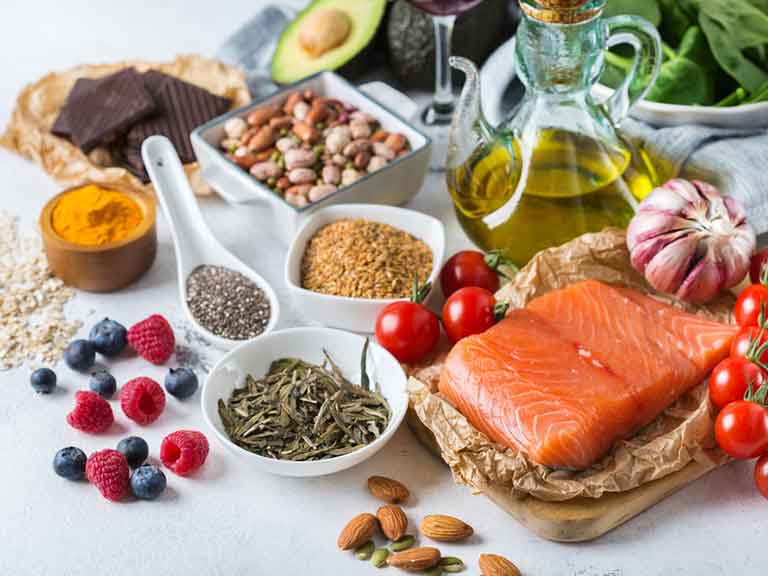Rachel Carlyle / 23 July 2019
Maria Borelius was feeling old and ill until she stumbled upon a new anti-inflammatory diet that changed her life.
It was 1 January 2013 and 52-year-old Maria Borelius was feeling bloated, her joints hurt, and her mood was decidedly grey. ‘I was beginning to think, is this what ageing is like – and if so what am I going to be like at 75 or 80? I had a phenomenal muffin top and a backache so bad I had to carry a little cushion to sit on everywhere I went.’
What happened next propelled science writer Maria, now 58, to the top of the bestseller lists in her native Sweden, and her book about how she rescued her life – Health Revolution – has just been published in the UK, where she has lived for almost 20 years.
Everything changed a few weeks after that dismal New Year’s Day when, by chance, she read about a middle-aged American housewife who had transformed her life through exercise and diet, with the help of Canadian personal trainer Rita Catolino. She decided to sign up for Rita’s three- month email course.
‘I was expecting a plan with tons of exercises, but the bulk of it was about diet,’ says Maria. ‘I was sceptical because as far as I was concerned I ate quite well – lots of vegetables and mainly home-cooked food, although I also liked toast and butter, desserts and wine.’
Rita told her to cut down dramatically on sugar, bread and pasta, to increase her vegetable intake still further, and to eat more protein, good fats, nuts, seeds and anti berries. There was also a weight-training schedule, and she was asked to fill in a daily ‘gratitude journal’.
Three months later, Maria found her back and joint pain had vanished and her abdominal fat had melted away. ‘I was also feeling so much more vibrant: the grey mood had gone and I felt 20 years younger.’
It wasn’t until she met a Swedish academic at the cutting-edge of nutritional research that she realised what she’d been eating was the ultimate disease-prevention diet. In Professor Inger Björk’s study, healthy volunteers who ate specially selected foods found their bad cholesterol fell by 33% and blood pressure by 8%. They also reported feeling younger and more alert.
‘I couldn’t believe it when I saw the list of foods they ate – it was exactly what I had been eating,’ says Maria.
The study diet was high in vegetables, omega-3 fatty acids (from oily fish), fibre, blueberries, almonds, cinnamon, vinegar and a special bread made of pre-cooked wholegrain. The volunteers cut their sugar and white flour intake. The preferred foods were all proven to have an anti-inflammatory effect on the body. And doctors now think the low-grade inflammation suffered by most people with a Western diet and sedentary lifestyle is linked to chronic health conditions such as Type-2 diabetes, cardiovascular disease, rheumatoid arthritis, irritable bowel syndrome, some cancers, dementia and depression.
The idea is that ageing, stress and eating the ‘wrong’ foods can set off the body’s immune system, activating its chemical ‘foot soldiers’ (cytokines, leukotrienes and prostaglandins), which cause inflammation – a key reaction when the body is under attack. Unlike the acute local inflammation you get when you cut your hand, this is a whole-body, low-grade response that lingers for years.
But how can inflammation be linked to such diverse diseases? ‘There may be different mechanisms involved in each,’ says Maria. ‘For heart disease there is a theory that inflammation irritates the blood vessels. In IBS it irritates the gut lining and in the joints the swelling causes pain. When it comes to psychiatric problems there are theories that cytokines can disturb the brain’s chemical balance.
‘I think science has been quite slow in putting all the information together because the different specialties don’t talk to each other. This is cutting-edge science that’s only now becoming common knowledge.’
It’s not just food that can cause inflammation: long-term stress has been shown to alter the immune response, which is why Maria says taking some time each day to unwind is so important, as is exercising.
She advises taking ‘baby steps’ towards an anti-inflammatory lifestyle. First, rethink breakfast (see below). Second, work up a sweat four times a week. ‘People think exercise is about burning calories, but the most important factor is that it lowers inflammation.’ Third, have a moment or two of spirituality or awe every day. ‘You don’t have to meditate – you could walk outside in nature, have a playlist of your favourite music that gives you goosebumps, or pray.’
Since the book was published in Sweden last year she’s received nearly 5,000 letters and emails from people who have tried the plan; older readers have found their joint pain and arthritis pain much reduced.
Maria has learned that if she goes back to her old ways, her backache returns after a couple of days. ‘I also notice my mood changes and I feel less positive and energised.’
Even Maria’s husband Greger is now a supporter. ‘At the beginning he got quite cross about all my “funny” ingredients in the kitchen. But when he turned 60 he ran a half-marathon in London and I made “my” food for him – roast salmon, sweet potato, boiled veg, olive oil and salad the night before, and on the day a smoothie with almond milk, blueberries, spinach, coconut oil and protein powder. He ran like a god with wings on his heels and afterwards he said, “I felt so light, so strong – what is this diet?” Since then he’s been on board.’











